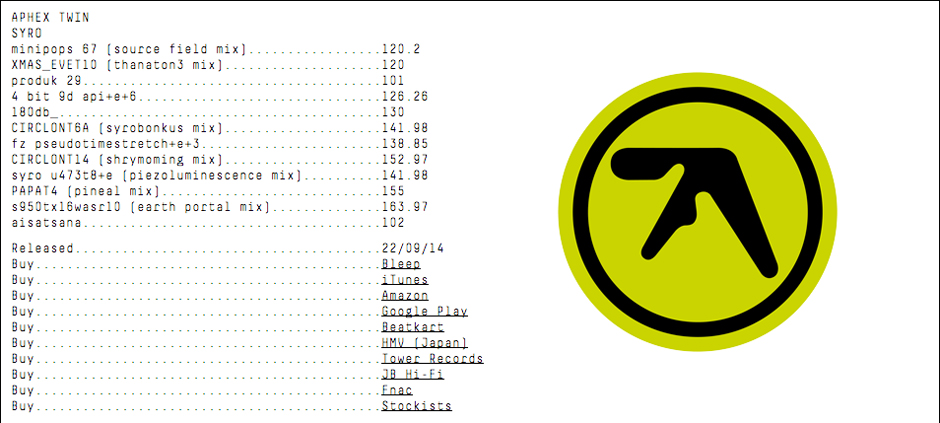
The Fake Aphex Twin Leak Is A Hyperreal Conundrum
A few weeks before electronic maverick Aphex Twin released his latest album, Syro, a friend slipped me the record so I could listen to it in advance. As the zip file downloaded, its vital signs looked promising. The thirteen garbled titles were written in classic Aphex style, with the requisite armory of uppEr and loWeR case and brackets (both round) [and square], and when I flicked through the tracks, it seemed like it might be the real deal. However, given Richard D. James’s penchant for troublemaking, I knew it might be a phony version of Syro that Warp Records launched into to the digital ether to screw with fans, a fake leak.
I couldn’t be certain either way, because the potential leak posed a hyperreal conundrum. If I liked the music and it turned out to be an imposter, I’d be the butt of Aphex’s practical joke. And what if the opposite happened—what if my skepticism about the veracity of the leak turned to cynicism, and I ended up hating Syro just because I thought it was a fraud constructed to con people who can’t tell the difference between authentic Aphex tunes and sneering knockoffs?
At first listen, the record ticked all the boxes. Glitchy percussion and pastoral synth melodies recalled the producer’s stellar run of albums in the mid-90s; the plucked synth strings that announce “nusxxtrabo780” were a dead ringer for “Goon Gumpas” from the Richard D James Album. The battering 808 claps of “fz pseudotimestretch+e+3” even matched the initial impact of Analogue Bubblebath.

In some ways, I felt more free listening to this potential leak than I would have if I had known for sure that I was hearing the real Syro. This was an opportunity to approach a record free of context, and without the reputation of a legendary electronic auteur coloring my listening experience. In theory, I should have been able to rely solely on my gut instinct as to whether the music was any good, and whether it was truly the work of Aphex Twin.
However, when I allowed myself to drift into this liberated head space, I found that this Syro wasn’t exactly a wild listen. The house piano samples on “CIRCLONT6A [141.98] (syrobonkus mix)” were naff and cloying, and the clumping military chug of “4 bit 9d api+e+6 [126.26]” left me cold. Everything felt underpowered and square, because the beats never spilled over the barlines and the melodies didn’t tug at the heart strings as I’d have hoped. If this leak had arrived with indisputable proof that it was helmed by the real Twin, I’d like to think I’d have felt short-changed—but it’s tricky to tell how I would have felt about it, or how much my knowledge of and preexisting relationship to its author would influence my opinion about the music itself.
It seems that IDM is easy pickings for a skeptical listener, and mischief is often mistaken for content by mediocre imitators and lustless fanboys. I’ve listened to a dead-eyed replica of Aphex Twin—a calling-card list of breakbeats, kid clips, and ambience—but I missed the sense of touch which dominate masterpieces like On.
Maybe the fake leak was James’s way of telling us that he wanted us to stop talking about Syro and to listen to it again.
Published October 09, 2014. Words by laurietompkins.
